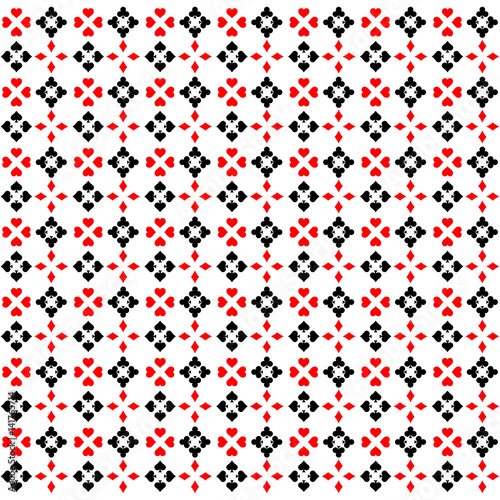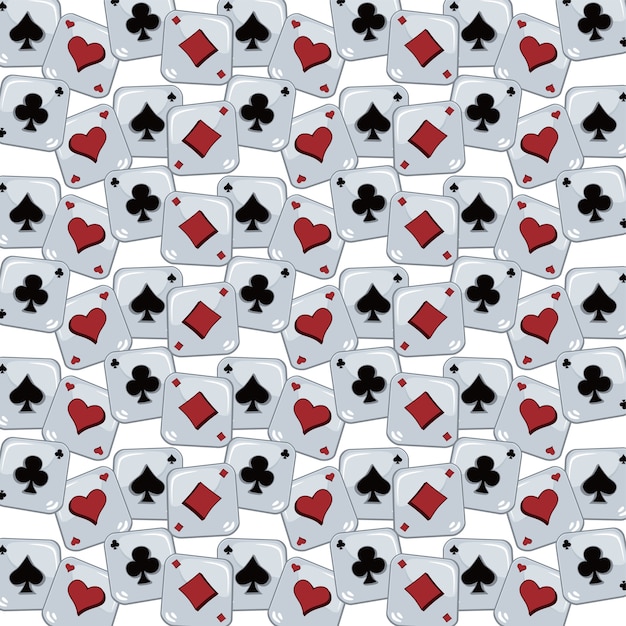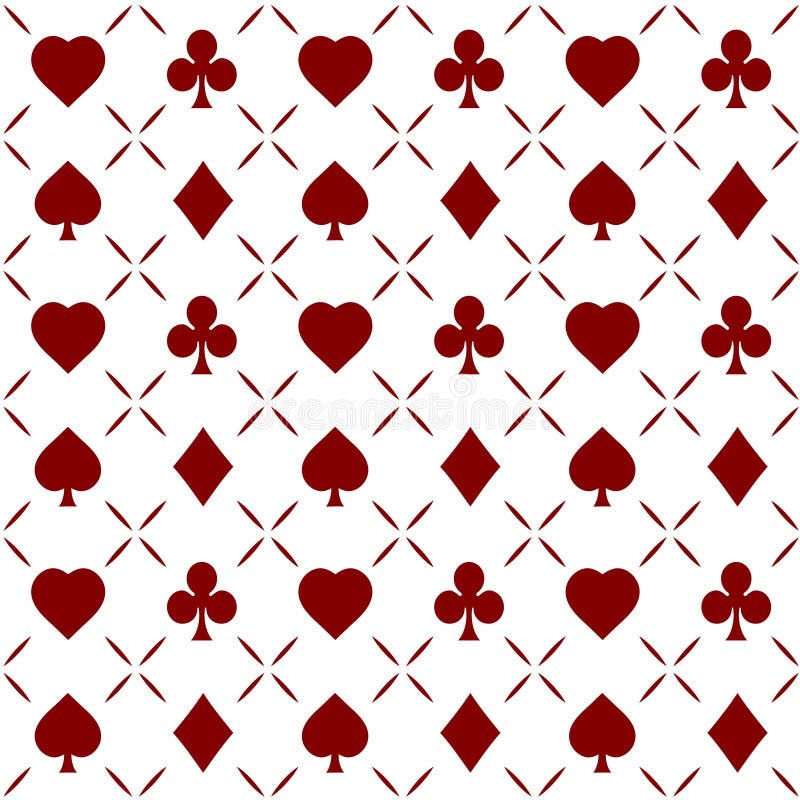Pattern Poker

We train in poker so that we can make the right decisions. Many of us dedicate a huge amount of off-table time to this game. It reminds me of a cheesy 90’s motivational poster of a wrestler in my high school gym class. The caption: “Train for months, win in seconds.” Training is why we. Check out our poker pattern selection for the very best in unique or custom, handmade pieces from our patterns shops.

I've just concluded another summer full of live poker tournaments in Las Vegas. This is always a time of reflection on the things that went well and the things that can be improved upon.
One thing that went well for me was making use of patterns that I picked up on in my opponents' play and behavior at the table. Here are a few examples of these 'poker patterns' that I looked for and relied upon.
Frequent Limpers
From hand number one, I start looking for behavioral patterns among the other players at the table, including those related to how they typically play their hands. The first thing that jumps out at me is whether or not a particular player limps. This is a sure sign of preflop passivity and usually a likely indicator of postflop passivity as well, although there are those who limp in preflop and go crazy postflop.
The cool thing is that passive players go to showdown often, so I can get a pretty clear idea of the types of hands with which they like to limp. From this observation, I can deduce which kinds of hands they like to raise. This allows me to play almost perfectly against both ranges going forward.
For example, many players like to limp with small pairs, small suited connectors, and suited wheel aces. I can attack these players with frequent bluffs because these hands do not make good bluff catchers. Instead, they usually miss completely and occasionally make strong value hands like two-pair-plus which are likely to raise my bluffs or weak-pair-plus-draw type hands that can call a few barrels, but not three unless they improve on the river.
When they make draws with no showdown value, these passive players tend just to call down and try to get there instead of rebluffing me with their draws as they should.
This limping range contains only small pairs and small suited cards which makes it a relatively tight range. Players who also limp many unsuited cards are in even worse shape facing my bluffs because these combos rarely make strong value hands.
However, a hand like J-To will often make a better bluff catcher than 5-4s or 5-5. If I am aware that a player's limping range contains more hands like this, then I switch from a bluff-heavy strategy to a value-heavy strategy on the later streets.
Regardless of the makeup of their limping ranges, you can exploit limpers' passivity almost perfectly by carefully recognizing which patterns they fall into.
Early Lookers
Another easily recognized pattern is displayed by players who look at their cards before the action gets to them. This one is extremely reliable because it happens almost every hand and because players generally have their guard down when the action is not on them, thus they are less concerned about information hiding with the bottom of their ranges.
For example, let's say there is an open from early position and I am in middle position. I will look at the players to my left and see how they react to the open before the action gets to them. They will often telegraph the fact that they plan to fold with the bottom of their ranges.
Many of them will literally hold their cards over the muck while they wait for me to act. Occasionally, they will give off tells with the middle and top of their ranges as well, but much less reliably.
Free Showdowns
In almost every small stakes tournament I played, there was usually at least one guy who showed his cards at showdown unnecessarily. Sometimes there were multiple players who did this, and I've even seen cases where a player showed almost every single time. This is a wealth of information that can be used to reverse-engineer a player's overall strategy if you can remember the action that preceded the showdown.
For example, I recently played a tournament at the Wynn in Las Vegas where a player opened for 5 BBs from early position. No one called, but the player unnecessarily showed that he had A-Qo.
A few hands later, this same player limped in from early position. An aggressive player raised and I looked down at A-Js in late position with about 25 BBs in my stack. The first player made the mistake of giving away the information that he likes to raise big with A-Q. I extrapolated that read to include A-K as well.
This information strengthened the relative value of my A-Js in this scenario, especially if the raiser was attacking the limp with a wider range designed to exploit this same information. This led me to make an easy shove with A-Js, thus taking advantage of the free showdown that was given on the previous orbit.
Genuine Verbal and Nonverbal Communication
Another pattern to look for is frequency of genuine verbal and nonverbal communication. Some players like to talk a lot at the table and are generally very happy and outgoing people. If a player like that suddenly stops talking or displaying his usually level of happiness, then you can deduce that something is also different about the way he plans to play.

Sometimes this happens when a player takes a bad beat. If you can recognize that he is tilting from it, you can expect him to play more recklessly than before. For example, a player who complains about being card dead will likely widen his ranges slightly as he gets shorter. If he shows down a hand that seems out of character, he will often say something like 'that is the best hand I've seen all day.' We've all seen this pattern before. If you can recognize and predict it, then you can exploit it.
I included the qualifier 'genuine' because some players are savvy enough to use their words to try and confuse you. I would not put too much stock into the things that this type of player says, but very few people are good at faking nonverbal, emotional responses. A player who is emotionally distressed will have a hard time hiding it and using it as a reverse tell is virtually impossible for most players.
Conclusion

Humans are creatures of habit. And most small stakes poker players are unaware of how their patterns of actions and behavior hurt them at the table.
These are just a few of the patterns I picked up on and exploited while playing this summer. Be on the lookout for these and others the next time you play live poker. Hopefully you will identify something that will help you to gain a reliable edge.
Tags
cash game strategytournament strategylimpingpreflop strategyrangesrange readingtellstable talklive poker
Patterns Poker is a game you can play to learn the subtle art of how to combine Patterns. We currently play this game with a deck of Design Patterns Playing Cards, but it may be played with other catalogs of Patterns or Pattern Languages.Patterns Poker was invented by Joshua Kerievsky, who has written up a brief history of the game.
Rules
If you’ve never played the traditional card game, Poker, don’t worry - you can learn to play Patterns Poker in a few minutes. The basic idea of Patterns Poker is to come up with great pattern combinations in order to tell a great story about them.
We’ll start by telling you how to play the game, and then explain how you can have even more fun by betting as you play.
There can be 2 to 14 players. If you are new to patterns or Patterns Poker you may enjoy teaming up with someone while you play. A hand consists of 5 cards. Jokers are wild (the holder of a joker can designate it as any card, except as a card already in his hand).
Procedure
- Cards are dealt. The dealer shuffles the deck 3 times. He then deals out the cards one at a time, face down, beginning with the player at his left. Each player is dealt 5 cards.
- Players study their cards. The goal is to look for great pattern combinations and stories you can tell about your cards. Perhaps all 5 cards you were dealt form an excellent story, complete with classic combinations of patterns. Or maybe you need to exchange a few cards (see below) to get the perfect hand. Players often find it helpful to consult the patterns literature while they study their cards.
- Players exchange cards. Each player has one chance to discard up to 3 cards in exchange for new cards. This is normally done in the same order in which the cards were dealt (though you don’t have to be strict about this if you want to save time). Place discarded cards in a separate pile and shuffle them back into the deck after a few hands.
- Players invent stories about their cards. Each player must invent a short story about his cards. The story could be about how a system, or part of a system, is implemented using the patterns. The story need not be about all 5 patterns, if 1 or 2 of the cards simply doesn’t fit in with the story. In some cases, a player may wish to tell a story about 3 cards, and tell another related story about the other 2 cards. Typically, the best stories show how all 5 cards work together in a system.
- Players tell their stories. Storytelling is the most important part of Patterns Poker. If you can tell your story well, you may win that deal. If your story is far-fetched, you probably won’t win. When everyone is ready, each player takes a turn to show his cards and tell his story. Storytelling usually takes about 1-4 minutes for each player. If someone doesn’t understand part of a story, he may ask for clarification. A player may also fold, meaning he drops out of the round because he doesn’t think he has a chance of winning. If he folds, he must use his turn to explain why his patterns wouldn’t work well together.
- The group decides on the best story. Once all players have told their stories, it’s time to decide who wins that deal. This is a judgement call for the group. If you have a designated dealer (who is not playing the game but just dealing cards), he can help make the final decision about the best story. The best stories typically involve a classic combination of patterns implemented in a plausible software system. Plausible stories about dense combinations of patterns usually have more value than stories about systems that implement patterns in diverse places (e.g. the database layer uses this pattern, the GUI uses that pattern).
Pattern Poker Table
The same sequence is repeated for the next deal.
Betting
It’s a lot of fun to bet while you play Patterns Poker, and you don’t need real money. In our Design Patterns Workshop, we often use candy for chips, though you have to be careful that players don’t eat their winnings during play! Hershey’s miniature assortment works well, and we typically use milk chocolate for the ante.
Before play, one player is selected as the banker. All chips are given to him to issue to players. Everyone gets the same amount of chips. Chip values are as follows:
- White chips have the lowest value.
- Red chips represent 2 white chips.
- Blue chips represent 4 white chips.
- Black chips represent 8 white chips.
Each deal is a separate game. Before each deal, every player contributes a minimum bet, called an ante, to form a pot. We typically use 1 white chip for the ante.
After players receive and look over their cards, they may increase their bets. When the first player increases his bet, each player after him may:
- drop by discarding his hand, thus giving up any chance to win the pot.
- call by matching the number of chips placed in the pot by the first player, or
- raise by placing enough chips in the pot to call plus one or more additional chips.
When it is his turn, a player should announce whether he is dropping, betting, calling or raising; if he is betting or raising, he should announce the amount.
A betting interval ends when every active player has had at least one turn to bet and when those bets have been equalized (i.e., when other players have matched or dropped). After the betting interval, players tell their stories, beginning with the player to the dealer’s left. All players tell a story, regardless of whether they have dropped or not. The player with the best story wins the pot.
Patterns Poker Photo Gallery
Check out our photo gallery of Patterns Poker being played at OOPSLA, SD East, and other places.
Pattern Play Game
Related Games
History of the Game
Author: Joshua Kerievsky
Created: October 11, 2000
One day, in the Spring of 2000, I was leading a small group of folks through our popular and intensive Design Patterns Workshop. By this point in the workshop, participants had studied 18 of the 23 Patterns covered in our class. This meant that we were close to realizing one of the workshop’s main objectives: to give participants a thorough education in all 23 Design Patterns from the classic book, Design Patterns: Elements of Reusable Object-Oriented Software.
That afternoon, while participants studied passages from the next Pattern in the series, I reflected on how each one of them was doing in the workshop. Just then I was greeted by a rather bothersome thought: while the participants and I had spent time during the workshop discussing the classic and not-so-classic combinations of Design Patterns, and how these combinations can help produce simple, flexible and extensible designs, I did not have confidence that each participant possessed a thorough understanding of this important subject.
And that lack of confidence bothered me.
The workshop clearly needed a way to measure what each participant understood or didn’t understand about combining Patterns. But how would I do that? After some reflection, I decided that a fun, non-threatening game would be just the right tool.
So I began brainstorming in class, searching for a game that would work. After tossing aside several ideas, I hit upon Poker, the popular U.S. card game. In traditional Poker, players win hands by combining cards in various ways. I simply needed participants to win hands by combining Patterns in various ways. Poker with Patterns?!?!
It was certainly worth a try!
Pattern Pokemon
Moments later, I assembled a set of playing cards, explained the new game to the participants and dealt the first hand of Patterns Poker. Twenty minutes later, I was delighted to discover that everyone loved the game! But even more important, the game helped participants review, clarify and retain their knowledge about Pattern combinations.
And that’s the story about how Patterns Poker came to be.
We are now happy to share this game with you. We hope you enjoy playing, and would love to hear about your experiences playing the game.